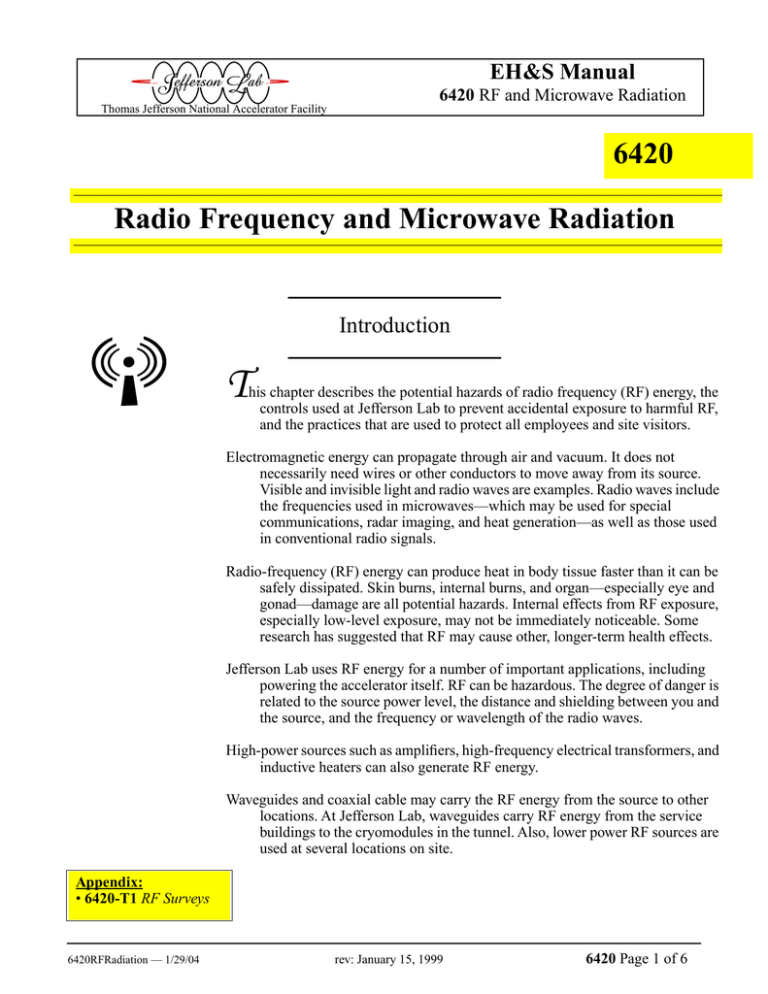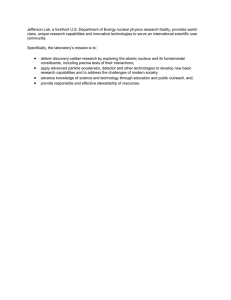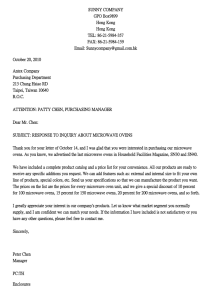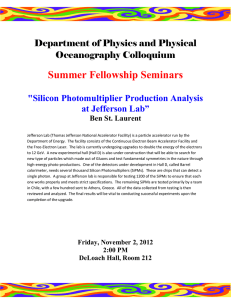6420 Radio Frequency and Microwave Radiation
advertisement

EH&S Manual 6420 RF and Microwave Radiation Thomas Jefferson National Accelerator Facility 6420 Radio Frequency and Microwave Radiation Introduction T his chapter describes the potential hazards of radio frequency (RF) energy, the controls used at Jefferson Lab to prevent accidental exposure to harmful RF, and the practices that are used to protect all employees and site visitors. Electromagnetic energy can propagate through air and vacuum. It does not necessarily need wires or other conductors to move away from its source. Visible and invisible light and radio waves are examples. Radio waves include the frequencies used in microwaves—which may be used for special communications, radar imaging, and heat generation—as well as those used in conventional radio signals. Radio-frequency (RF) energy can produce heat in body tissue faster than it can be safely dissipated. Skin burns, internal burns, and organ—especially eye and gonad—damage are all potential hazards. Internal effects from RF exposure, especially low-level exposure, may not be immediately noticeable. Some research has suggested that RF may cause other, longer-term health effects. Jefferson Lab uses RF energy for a number of important applications, including powering the accelerator itself. RF can be hazardous. The degree of danger is related to the source power level, the distance and shielding between you and the source, and the frequency or wavelength of the radio waves. High-power sources such as amplifiers, high-frequency electrical transformers, and inductive heaters can also generate RF energy. Waveguides and coaxial cable may carry the RF energy from the source to other locations. At Jefferson Lab, waveguides carry RF energy from the service buildings to the cryomodules in the tunnel. Also, lower power RF sources are used at several locations on site. Appendix: • 6420-T1 RF Surveys 6420RFRadiation — 1/29/04 rev: January 15, 1999 6420 Page 1 of 6 EH&S Manual Thomas Jefferson National Accelerator Facility 6420 RF and Microwave Radiation Key Terms ANSI/IEEE American National Standards Institute and the Institute of Electrical and Electronic Engineers. These two organizations have collaborated to produce two standards, “Recommended Practice for the Measurement of Potentially Hazardous Electromagnetic Fields — RF and Microwave.” Its reference number is C95.3–1991. (Also the “IEEE Standard for Safety Levels with respect to Human Exposure to Radio Frequency Electromagnetic Fields” C95.1 3 kHz to 300 GHz.) microwave Electromagnetic radiation with frequencies in the range 300 MHz–300 GHz. radio frequency (RF) radiation Generally, electromagnetic energy with frequencies in the range 10 kHz–300 GHz. Sometimes the term is used to refer more narrowly to the frequency range below 300 MHz. waveguide A (usually) hollow metal duct used to contain and direct RF energy along a desired path. 6420 Page 2 of 6 rev: January 15, 1999 6420RFRadiation — 1/29/04 EH&S Manual Thomas Jefferson National Accelerator Facility 6420 RF and Microwave Radiation Hazard Avoidance RF exposure limits are based on thermal effects. The Institute of Electrical and Electronics Engineers (IEEE) has established a standard (frequency dependent) for exposure to RF (see appendix.) Experts believe exposures at or below this level will cause no adverse health effects. The Jefferson Lab accelerator operates at 1.5 GHz. Microwave ovens are subject to a separate standard for maximum RF leakage: 1 mW/cm2 at a distance of 5 cm from the exterior for new ovens, and 5 mW/cm2 for ovens in service. Other RF frequencies may have higher or lower recommended exposure levels. Avoid needless exposure to RF energy of any frequency. To prevent injury, observe these general good work practices: ✔ Stay out of areas that have RF warning signs or flashing lights unless you have training and authorization to enter. ✔ Unless you are trained and qualified, never alter a piece of RF equipment or attempt to make it operate in a manner for which it was not designed. ✔ Damage to high-power RF equipment may create a stop-work situation. (See Chapter 3330 Stop-Work Orders.) Report such damage immediately to the appropriate line manager. Never open an energized waveguide or disconnect an active coaxial cable unless you are certain that the resulting power density will be less than 5 mW/cm2. ✔ RF can interfere with instruments and electrical apparatus, including heart pacemakers. If you wear a pacemaker or other sensitive electronic biomedical equipment, consult with your physician and Jefferson Lab Medical Services before working near RF equipment. ✔ Metal surgical implants can produce localized heating in strong RF fields. Check with your doctor and Jefferson Lab Medical Services if you have implants and work with RF equipment. ✔ Never store flammable materials near RF sources. ✔ Use microwave ovens properly, and keep them clean. Do not use an oven with a damaged door seal or cabinet, or one with food spilled on the door-seal area. Do not tamper with the door safety-interlock mechanism. 6420RFRadiation — 1/29/04 rev: January 15, 1999 6420 Page 3 of 6 EH&S Manual Thomas Jefferson National Accelerator Facility 6420 RF and Microwave Radiation Responsibilities Individual ❖ If your job requires you to work with RF or microwave equipment, you must ensure that the RF energy is properly confined. Manufactured enclosures, field-fabricated shielding, waveguides, and safety accessories must be intact at all times while the equipment is powered. Follow all established procedures. Supervisor ❖ Identify equipment that could be a source of hazardous RF radiation and establish appropriate work procedures ❖ Ensure that only qualified personnel work on potentially hazardous RF systems ❖ Conduct a hazard evaluation for RF sources. Include an RF survey whenever potentially hazardous levels of RF are involved and: • New RF-generating equipment is commissioned • Existing equipment is modified • There is an indication of possible RF leakage ❖ Maintain reference materials such as ANSI/IEEE C95.3 & C95.1 and manufacturers’ literature EH&S staff ❖ Perform (or arrange for) testing of RF field strength whenever there appears to be a potential exposure problem or whenever so requested by line management ❖ Conduct at least yearly audits of RF sources capable of producing >10 watts The Accelerator Division Industrial Hygienist provides technical assistance for RF leakage measurement, including the testing of microwave ovens, calibration of survey equipment and for evaluation of individual employees' RF exposure. RF field-strength measurement data must be documented, particularly when personal exposure is being evaluated. Appendix 6420-T1 RF Surveys describes RF surveys, why they are made, and how to conduct them. 6420 Page 4 of 6 rev: January 15, 1999 6420RFRadiation — 1/29/04 EH&S Manual 6420 RF and Microwave Radiation Thomas Jefferson National Accelerator Facility Practices 2 Individual exposure to RF radiation must not exceed 5 mW/cm for the accelerator RF frequency. Other frequencies have different exposure levels. For example, the maximum exposure level for 100–200 MHz is l mW/cm2. ❖ Measurement of RF levels and the interpretation of the data must be done in accordance with accepted guidelines. It is Jefferson Lab practice to use the American Conference of Governmental Industrial Hygienists (ACGIH) or ANSI/IEEE methods; consult the Accelerator Division Industrial Hygienist. 6420RFRadiation — 1/29/04 rev: January 15, 1999 6420 Page 5 of 6 EH&S Manual Thomas Jefferson National Accelerator Facility 6420 RF and Microwave Radiation ❖ Shield all RF sources and transmission equipment to ensure that no significant leakage occurs. Whenever feasible, high-power waveguides must be pressurized, with loss of pressure automatically deactivating the RF source. Safety interlocks, electrical insulation, and grounding systems must be incorporated into RF equipment design and installation. ❖ Strong RF fields can induce hazardous voltages in other equipment or surfaces, producing other types of hazards. For example, RF can produce high electric fields in the accelerating cavities, which, in turn, can cause field emission and ionizing radiation. Pay attention to any posted notices about safe working distances around RF equipment. ❖ Klystrons with isolated collectors and capacitive-gap shields pose an exceptional leakage hazard. If such klystrons are used, an interlock which detects leakage must also be used. ❖ To identify areas or enclosures in which RF overexposure is possible, use conspicuous markings, such as the ANSI symbol shown below. Wherever overexposure is possible, control these areas to restrict unauthorized access. ANSI symbol for RF Microwave ovens All microwave ovens on site must be tested for leakage after repairs. Most RF leakage from microwave ovens is the result of deteriorated or food-caked door gaskets. Make sure the oven door closes completely, and nothing interferes with the sealing surface. Do not use microwave ovens with damaged cabinets or doors under any circumstance. Remove them from service immediately, and notify the responsible supervisor of the condition. 6420 Page 6 of 6 rev: January 15, 1999 6420RFRadiation — 1/29/04



